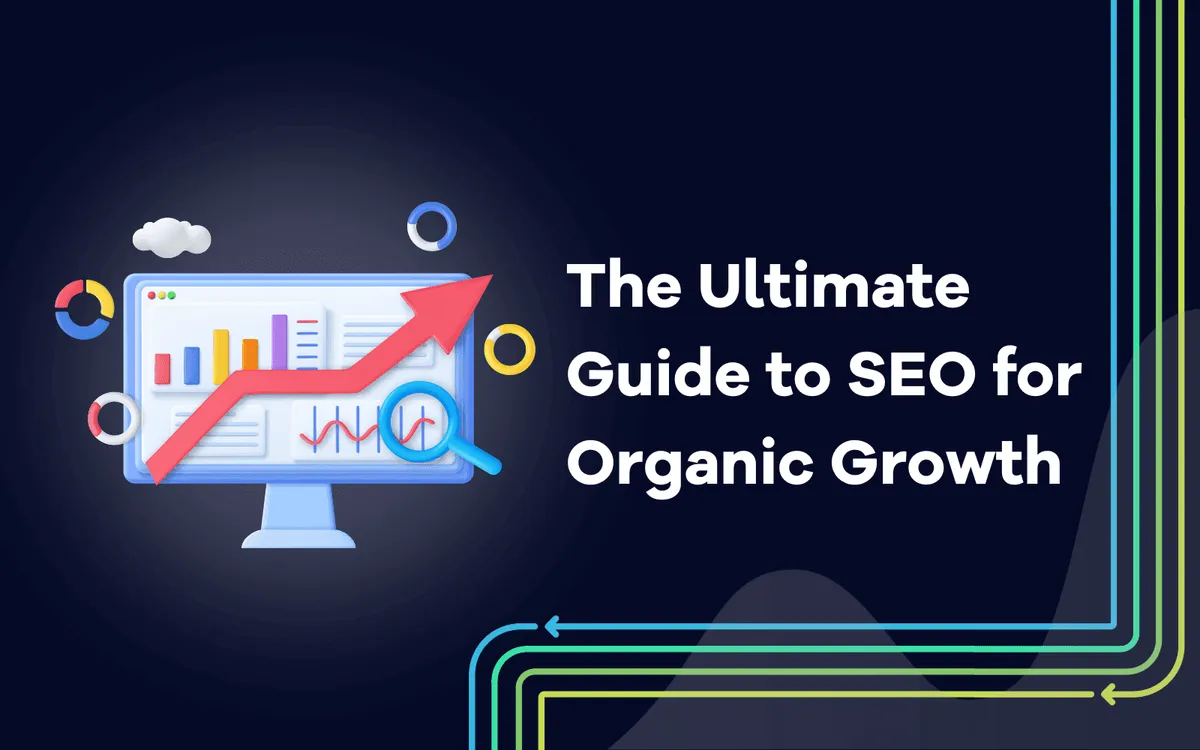
The Ultimate Guide to SEO for Organic Growth: Long-Term Strategies Unveiled
February 12, 2024
Discover the secrets of SEO for organic growth and master long-term success strategies. Dive into our comprehensive guide for sustainable digital growth in 2024.
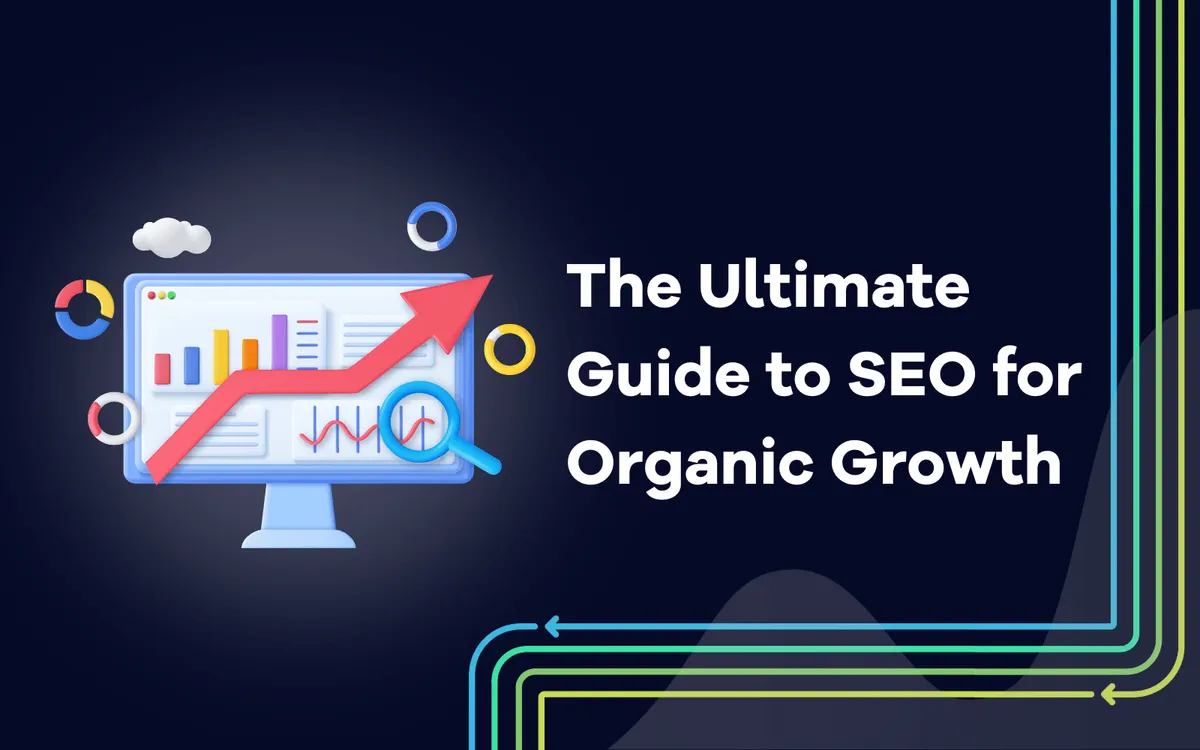
In a digital world where instant gratification has become the norm, the art of achieving long-term success can seem like a lost cause. But what if I told you that the key to achieving online growth lies not in quick fixes but in a steady, sustainable approach?
With organic traffic accounting for 53.3% of a website's traffic, SEO has become an indispensable tool to grow online today. But how do you ensure that your website doesn't just climb the rankings but also maintains its position long-term?
We'll understand this by diving deep into SEO for organic growth—not the quick, algorithm-chasing kind, but SEO strategies that stand the test of time. As we enter 2024, the search engine landscape continues to evolve at a breakneck pace. This makes building a solid SEO foundation that withstands the ever-changing tides of algorithms and market trends more crucial than ever. So, let's dive in!
What is organic growth?
Organic growth is the process of attracting and engaging an audience naturally without relying on paid advertising. In SEO, organic growth means enhancing your website's visibility and attracting more visitors through search engines like Google or Bing without paying for each click or impression.
At its core, organic growth is about building trust and credibility with both search engines and users. It's a slow and steady journey, where the focus is on creating valuable content, optimizing website performance, and ensuring a user-friendly experience.
This enhances your website's visibility and ranking in search engine results pages (SERPs). When your website appears higher in these results, especially on the first page, it naturally attracts more visitors. This is because the organic search result on the first page is 10x more likely to receive a click, and 75% of users never scroll past this first page.
Additionally, organic growth shows how good and valuable your website is. If more people are visiting and interacting with your site naturally, it means that your site is offering something useful.
How does SEO work to boost organic growth?
SEO is basically about understanding how search engines like Google operate and enabling them to showcase your content to the right audience. You can consider search engines as digital librarians who use complex algorithms to filter through billions of web pages and present the most relevant ones to users. By optimizing your website for SEO, you're essentially making it easier for these search engines to find, understand, and display your content in search results.
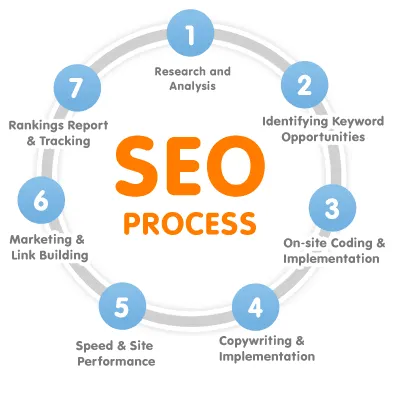 Source: Medium
Source: MediumKeywords play a pivotal role in SEO for organic growth. They are the words and phrases that people type into search engines when looking for information. By incorporating these keywords into your website's content, you're signaling to search engines that your site is relevant to those questions.
Additionally, search engines prioritize content that is informative, engaging, and valuable to users. This means creating content that answers your audience's questions, solves their problems, or entertains them. High-quality content is more likely to be shared, linked to, and referenced. All of this works to bring organic traffic to your website.
Website localization also significantly impacts SEO. It involves adapting your website to different languages and cultural contexts, ensuring it resonates with various audiences. Localization goes beyond mere translation, encompassing cultural nuances, local keywords, and regional search engine preferences. This tailored approach not only enhances user experience but also improves visibility in local search results, thereby contributing to organic growth on a global scale.
Why is a long-term SEO strategy hard to achieve?
Launching a long-term SEO strategy can be challenging and requires patience, persistence, and a deep understanding of the ever-evolving digital landscape.
This is mainly because search engines like Google frequently update their algorithms. These changes can significantly impact how websites are ranked. What works for SEO today might not work tomorrow. Keeping up with these changes and adapting your strategy accordingly can be daunting. It's a game of staying informed and flexible, which requires both time and effort.
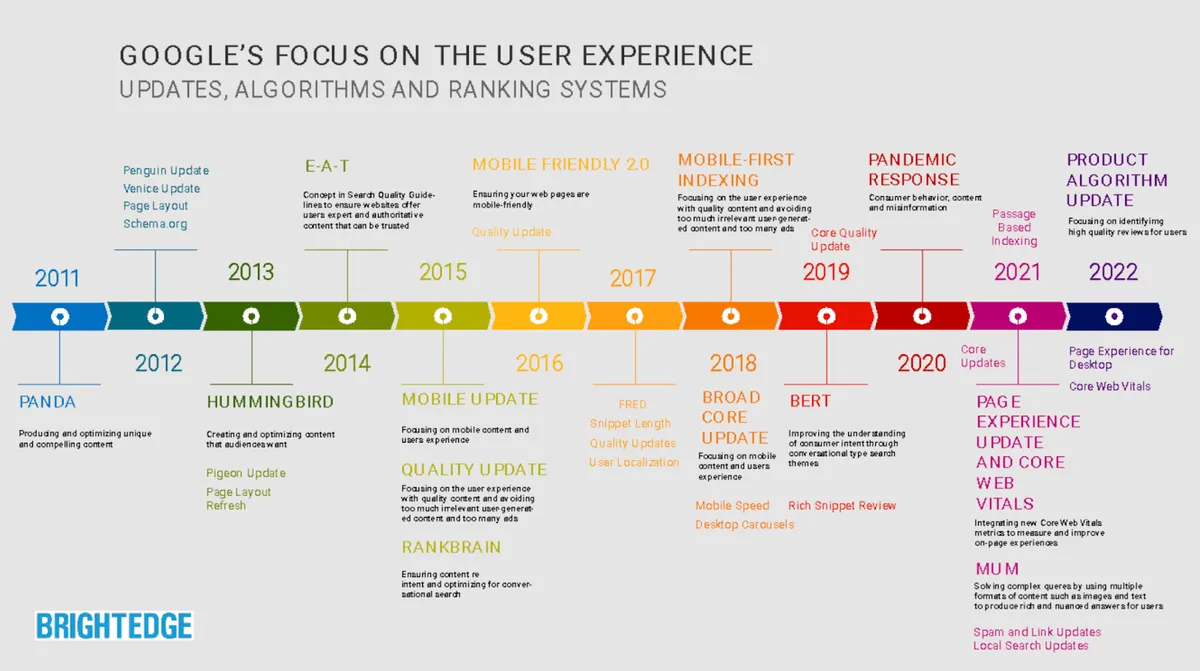 Source: Brightedge
Source: BrightedgeThe digital space is also becoming increasingly competitive. With more businesses competing for visibility, standing out in search engine results pages (SERPs) becomes more challenging. As your competitors evolve and improve their SEO strategies, you must do the same to maintain or improve your rankings.
Additionally, with the rise of mobile browsing, voice search, and artificial intelligence (AI), SEO for organic growth strategies must continually evolve. Keeping up with these technological trends and integrating them into your SEO strategy can be daunting. Unlike paid advertising, where results can be seen almost instantly, SEO for organic growth takes time to show results. This delay can be frustrating and might lead some to abandon their long-term strategy in favor of short-term gains.
8 long-term SEO strategies to drive more organic traffic to your site
A well-planned SEO strategy is your roadmap to success while pursuing long-term organic growth. Here are 8 SEO for organic growth strategies that can help drive more organic traffic to your site:
#1. Conduct thorough audience research
Understanding your audience is the foundation of any successful SEO strategy. Before diving into keyword research or content creation, it's crucial to know who you are targeting.
You need to answer the following questions to help understand your audience and their challenges:
Who are they?
What are their ages, interests, and occupations?
What are they looking for when they go online?
Are they seeking information, looking to make a purchase, or solving a problem?
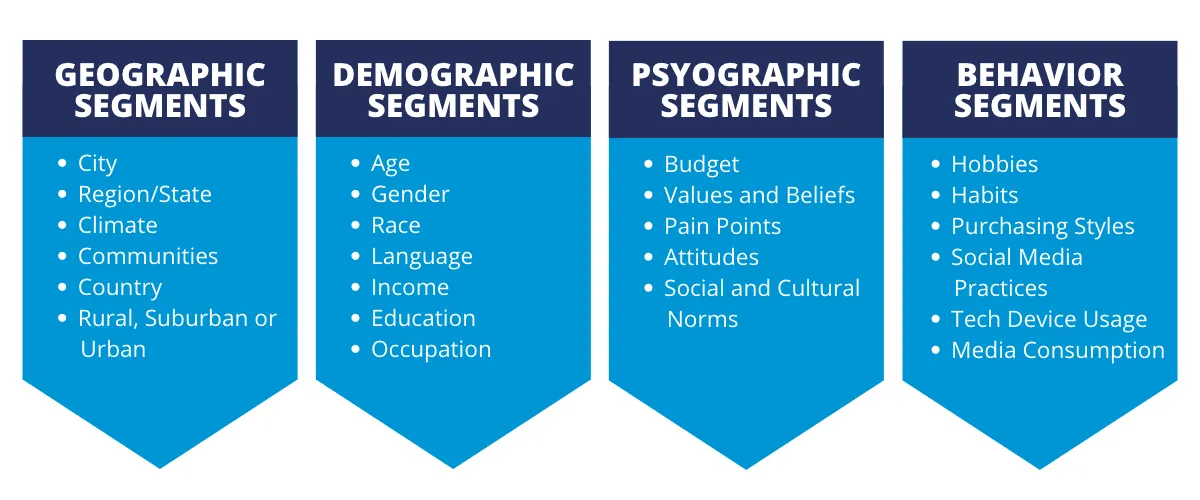
Source: Waypointmc
Knowing your audience and figuring out their search intent allows you to create content tailored to them and content that answers their queries directly. You can use tools like Google Analytics to understand how your audience interacts with your website. Look at metrics like most visited pages, time spent on site, and bounce rate to gauge what captures their interest.
Social media platforms can be a gold mine for audience research. Pay attention to the discussions, questions, and content your target audience engages with on these platforms. Look at your competitors' websites and social media. See what kind of content is resonating with their audience, which could be similar to yours.
#2.Conduct SEO site audits
An SEO site audit is a critical step in shaping your long-term strategy. It's like a health check for your website, identifying areas that need improvement and opportunities to enhance your online presence.
Start by examining the overall structure of your site. Is it easy to navigate? Do the pages logically flow from one to another? A well-structured website helps both users and search engines find information easily.
With the increasing use of mobile devices, also ensure your site is mobile-friendly. Google's Mobile-Friendly Test can help you see how your site performs on mobile devices.
Furthermore, use tools like Google PageSpeed Insights to check the loading speed of your website. Slow loading times can negatively impact user experience and your site's ranking.
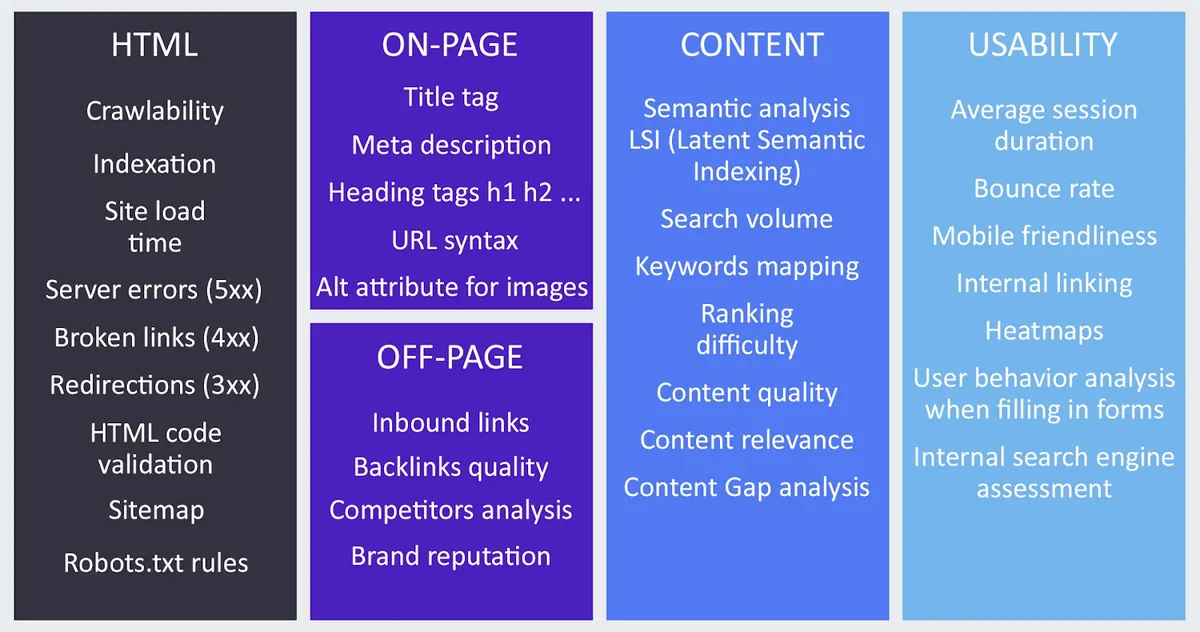 Source: Searchengineland
Source: Searchengineland#3. Create high-quality content
Create high-quality, unique content in various formats that address these gaps, focusing on relevant and valuable topics for your audience. You can use SEO tools to conduct a keyword gap analysis between your site and your competitors. This can reveal keywords they rank for, but you don't, offering a clear direction for new content.
You have to stay updated with industry trends and hot topics. Tools like Google Trends can help you identify what's currently capturing your audience's interest, allowing you to create timely and relevant content.
Additionally, pay attention to your customers' questions and concerns. These can be a gold mine for content ideas that address real issues and queries your audience has. Platforms like Reddit, Quora, and niche forums are great for discovering what your target audience is talking about. These discussions can inspire content that resonates with their interests and needs.
To enhance your content creation strategy further, consider incorporating AI-generated videos, this will allow you to transform written content into compelling visual stories, making complex topics more accessible and enjoyable for your audience. This approach not only diversifies your content format but also keeps you at the forefront of technological trends, further establishing your brand as a forward-thinking and innovative leader in your industry.
In the dynamic sphere of digital marketing, transforming complex written content into visual formats can significantly enhance audience engagement and comprehension. Take, for example, the intricate subject of e-commerce and freight analytics. This topic, crucial for the operational success of online businesses, can be dense and challenging to digest in a purely textual form. By converting the insights from a detailed exploration, such as the transformative impact of freight analytics in the e-commerce sector, into compelling visual stories or infographics, we can make this information more accessible and enjoyable for our audience. Visual representations not only simplify complex data but also cater to the diverse preferences of our digital audience, making learning an engaging experience. This approach underscores the importance of adopting innovative content strategies that align with our long-term SEO goals, ensuring that our audience remains informed, entertained, and engaged.
#4. Update and optimize existing content
Refreshing and optimizing your existing content is as crucial as creating new material. This strategy not only enhances the relevance and quality of your content but also boosts your SEO efforts.
Periodically review your content to identify pieces that are outdated, underperforming, or no longer relevant. This helps in prioritizing which content needs updating. Ensure that all the information is current and accurate. This includes updating statistics, facts, links, and any references to dated material.
Revisit your keywords. Are they still relevant? Could you target new keywords? Also, optimize title tags, meta descriptions, and headers to improve search visibility. Don’t forget to review and update internal links within your content. This not only helps with SEO but also encourages users to explore more of your website.
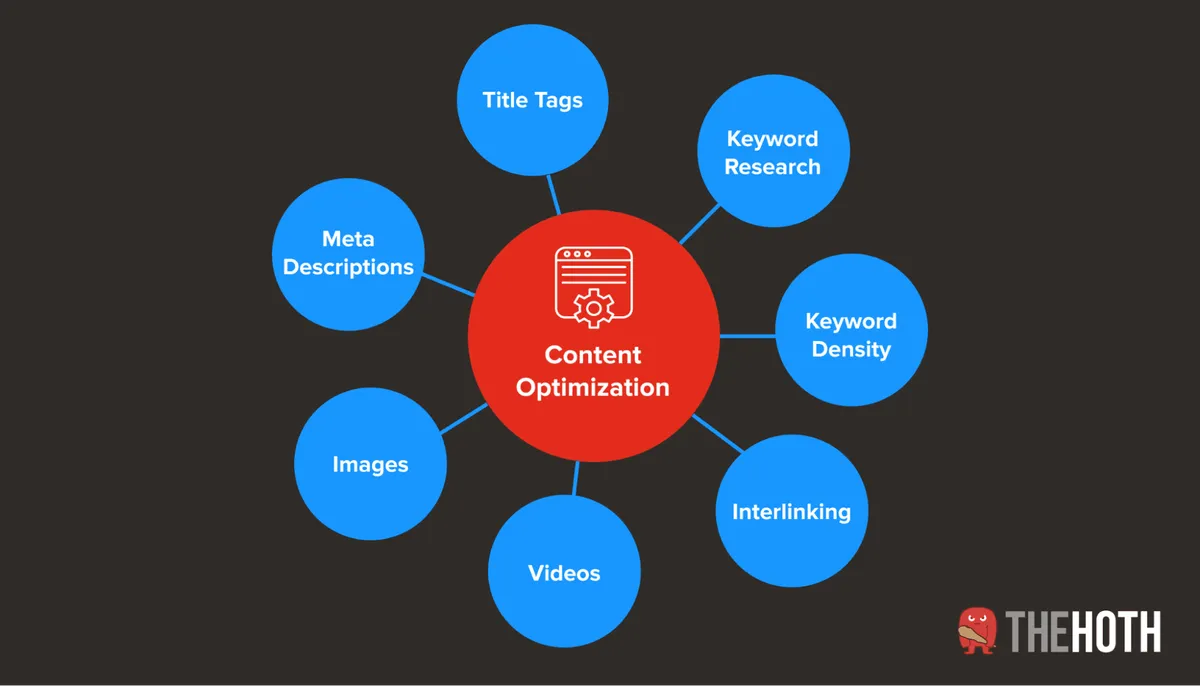 Source: Thehoth
Source: Thehoth#5. Analyze and imitate top-performing pages
Learning from your top-performing pages is a smart strategy in SEO. These pages are doing something right, and understanding their success can provide valuable insights for your other content.
Use analytics tools to determine which pages on your site attract direct and organic traffic, have the lowest bounce rates, or rank well for key terms. Look at various factors like the content quality, the keywords they rank for, the user experience, the page design, and the type of engagement they receive. Understanding why these pages are successful can help you replicate these elements in other areas.
Analyze the keywords that these pages rank for. Consider how you can apply similar keyword strategies to other pages or new content. If the tone and style of these pages resonate well with your audience, consider adopting a similar approach in your other content.
#6. Build a robust link structure
Linking, both internal and external, is a powerful tool in SEO. It not only helps in navigating your website but also establishes credibility and authority.
Internal links are links that go from one page on your domain to another. They help users navigate your site and allow search engines to understand the structure of your website.
Use high-quality internal links to guide users to related content, improving their overall experience and keeping them engaged longer. When adding internal links, ensure they are relevant and logical. Linking should feel natural and add value to the user’s experience, not just be done for the sake of SEO.
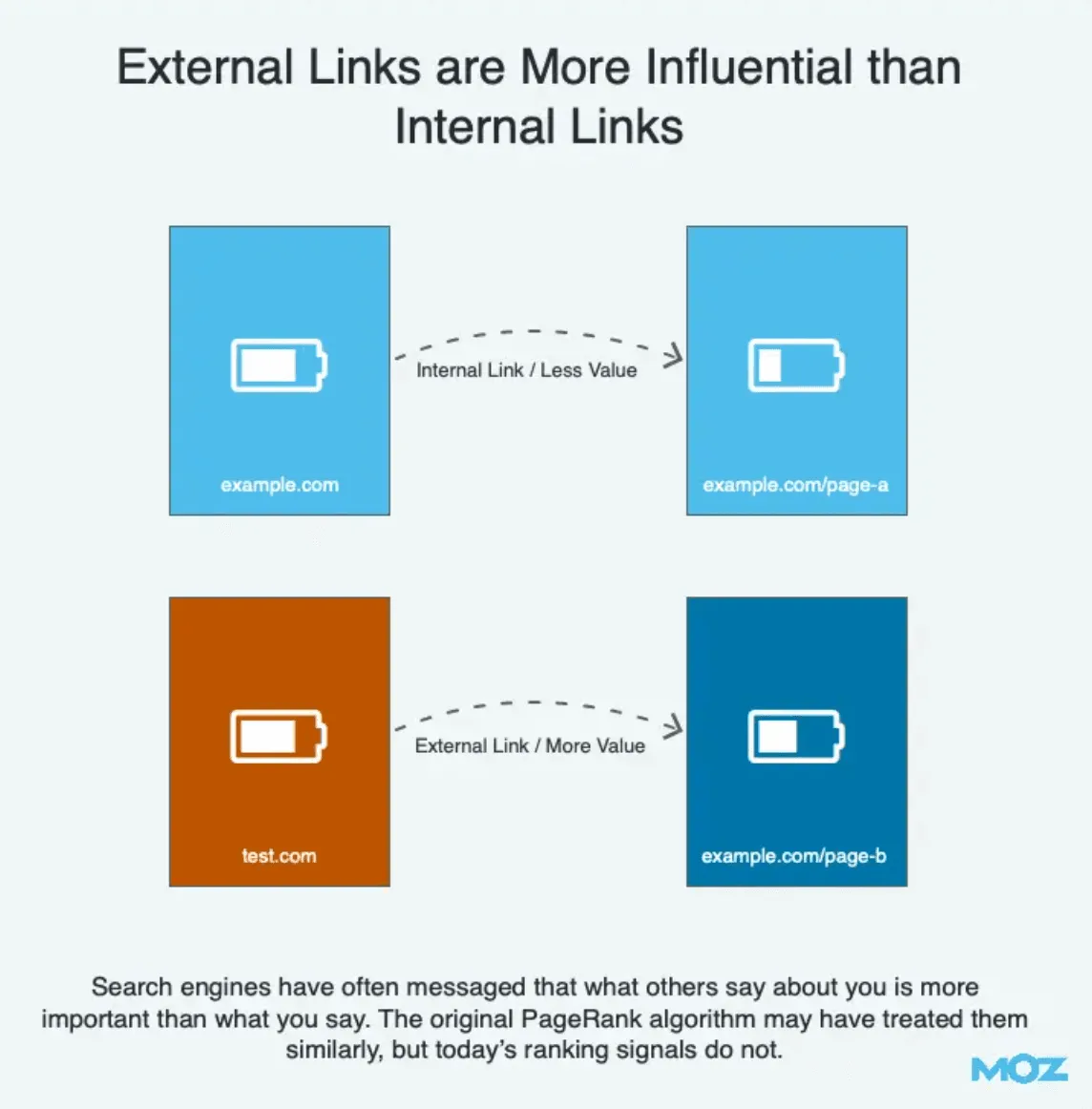 Source: Moz
Source: MozExternal links are links from your site to another domain. Linking to authoritative and relevant external sources can boost the credibility of your content. It shows that your content is well-researched and backed by reliable sources. Ensure that the external sites you link to are reputable and authoritative. Linking to low-quality or spammy sites can negatively impact your SEO for organic growth.
Additionally, make sure to periodically check your internal and external links to ensure they are still relevant and working. Broken links can harm your website’s user experience and SEO.
#7. Utilize schema markup
Schema markup is a code that you put on your website to help search engines produce more informative results for users. It tells search engines what your data means, not just what it says. Basically, implementing Schema markup helps search engines understand and display your content effectively, thus enhancing your visibility in SERP.
Tools like Google's Structured Data Markup Helper can guide you in creating schema markup. You don't need to be a coding expert—these tools are user-friendly and provide step-by-step assistance. Once you have created your schema markup, add it to the HTML of your web pages. This can be done directly or through a CMS if you're using one.
#8. Pay more attention to title tags, meta descriptions, & alt texts
Title tags, meta descriptions, and alt texts are essential elements of SEO that often don't get the attention they deserve. These components are crucial for both search engine optimization and user experience.
Title tag: The headline that appears in search engine results. It should be concise and relevant, and it should include your primary keyword. Aim for a length of 50-60 characters to ensure it displays properly in search results.
Meta description: A brief summary of a page's content that appears under the title in search results. While it doesn't directly impact rankings, a well-written meta description can improve click-through rates. Keep it under 160 characters and make it engaging.
Alt texts: Also called as alternative texts, describe the content of images on your website. They are crucial for accessibility and help search engines understand the images on your site. Ensure every image has a descriptive alt text, incorporating relevant keywords where appropriate.
Each title tag, meta description, and alt text should be unique and accurately describe the content of the page or image. Also, ensure that you include keywords strategically. While including keywords is important, they should be used naturally. Avoid keyword stuffing, as it can negatively impact your SEO efforts.
Furthermore, make sure that your title tags and meta descriptions accurately reflect the content of the pages they describe. Misleading titles or descriptions can increase bounce rates.
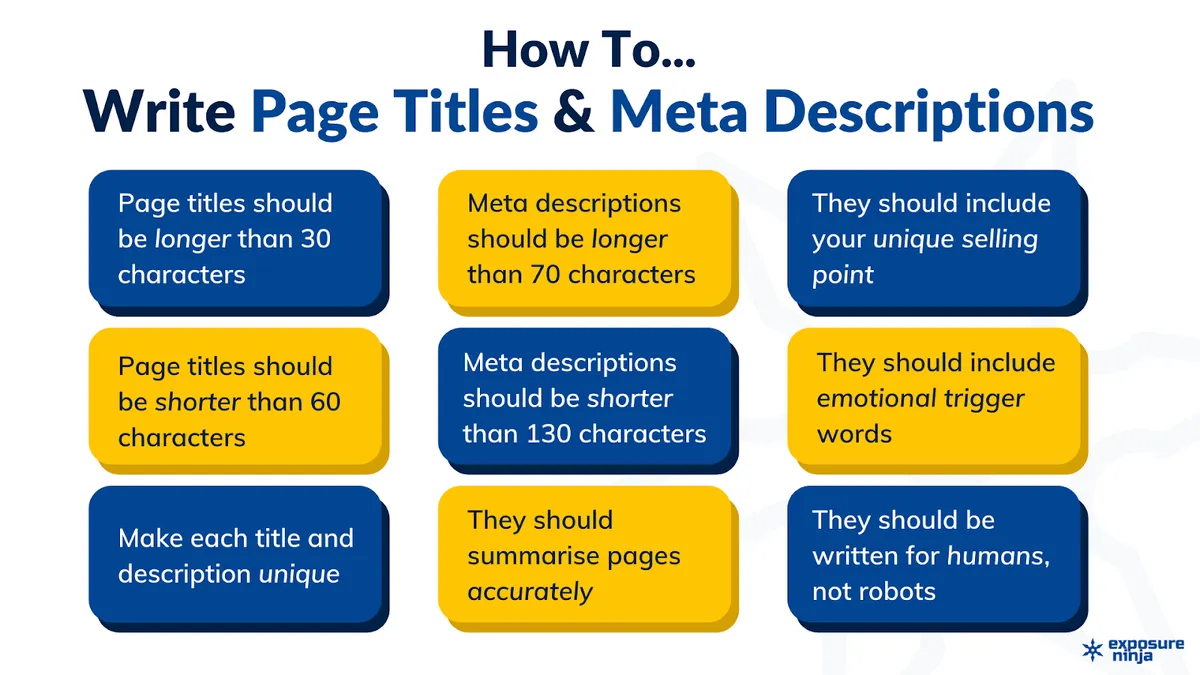
Source: Exposureninja
How to adapt your SEO strategies for long-term success amid algorithm changes
Search engine algorithms are constantly evolving, with Google frequently updating its algorithm to improve the relevance and quality of search results. These updates can significantly impact the visibility of websites in search engine results pages (SERPs), making it crucial for you to stay informed and adapt their strategies accordingly.
Here are some best practices to follow to stay ahead of the changing algorithm:
Create content that is informative, engaging, and provides value to your audience. Avoid tactics like keyword stuffing. Instead, use keywords naturally and contextually.
Ensure your website is user-friendly, with intuitive navigation and a clean design. Optimize for mobile users, as mobile-friendliness is a key factor in search rankings.
Avoid black-hat SEO techniques such as cloaking, using private link networks, or duplicating content. Stick to ethical, white-hat SEO practices that comply with search engine guidelines.
Conduct periodic SEO audits to identify and fix issues like broken links, slow loading times, or crawl errors.
Include E-E-A-T (Experience, Expertise, Authoritativeness, Trustworthiness) in your SEO strategy. With the surge in AI-generated content, Google has started valuing content that demonstrates experience, expertise, and credibility. Showcase your or your authors' expertise and provide trustworthy, well-sourced information.
Align your content strategy with the user's search intent, providing comprehensive and useful information. This approach is essential to thrive in the wake of helpful content updates.
Finally, be prepared to make changes to your SEO strategy in response to algorithm updates. Test different strategies and be open to evolving your approach based on what works best.
FAQs related to SEO for organic growth
Here are some of the frequently asked questions related to organic SEO growth:
How much does organic SEO cost?
The cost of organic SEO services in 2024 varies widely depending on the scope of the project, the size of the company, and the service provider.
Here's a general overview of the pricing:
Monthly retainers: For most SEO projects, businesses can expect to pay between $2,500–$7,500 per month. This range is typical for larger projects and depends on the specific needs and goals of the business.
One-time projects: The average cost for one-time SEO projects ranges from $5,000 to $10,000.These projects might include comprehensive website audits, overhauls, or specific campaign launches.
Hourly rates: SEO specialists may charge hourly rates that range from $75–$100 per hour. This rate can vary based on the specialist's experience and expertise.
Small businesses: For smaller businesses, the average monthly costs range from $500 to $1,500. These packages typically include basic services like keyword research, on-page optimization, and some level of content creation or modification.
The cost of SEO services also depends on the competitiveness of the industry and the market. More competitive markets may require a higher investment to achieve significant results.
It's important to note that these prices are averages and can vary based on the specific needs and goals of each business. Quality and effectiveness of services should also be considered alongside cost when choosing an SEO provider.
What is organic ranking in SEO?
Organic ranking in SEO refers to the position a website or web page holds in the search engine results pages (SERPs) without the influence of paid advertising. This ranking is achieved through organic search engine optimization (organic SEO), which involves various methods and strategies to improve a website's visibility and ranking in search engines like Google.
Organic search rankings are achieved without paying for ads. Unlike paid search results (which are advertisements), organic search results are purely based on the relevance and quality of the content in relation to the search query. These results are determined by search engine algorithms that take into account numerous factors, including keywords, website structure, user experience, mobile-friendliness, page loading speed, backlinks, and content quality.
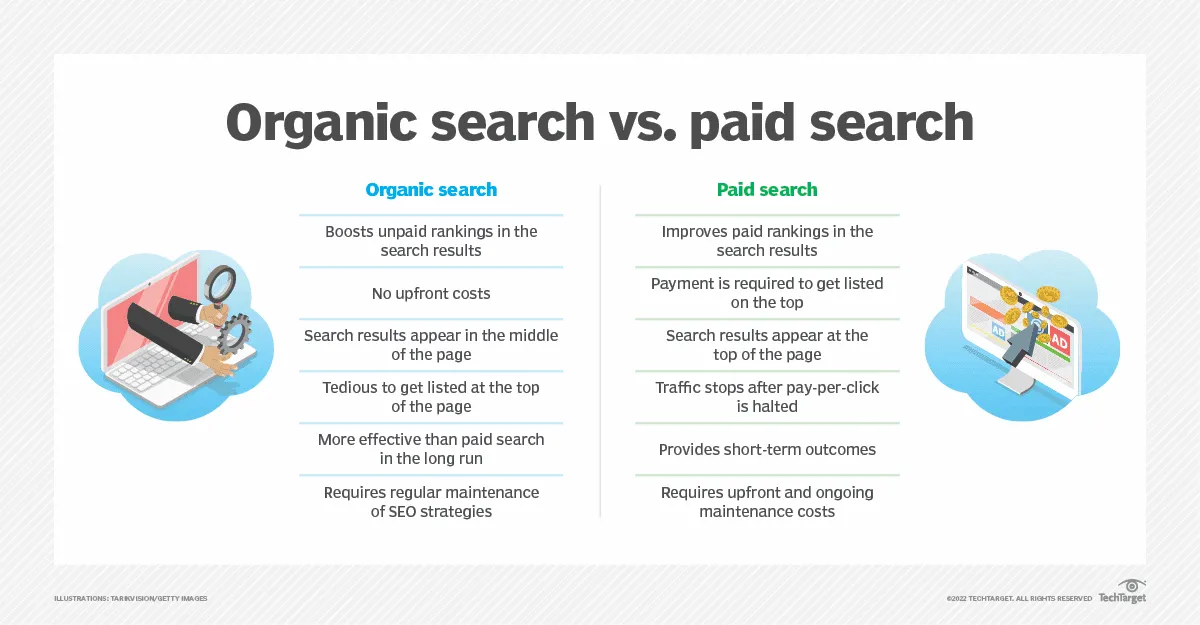 Source: Techtarget
Source: TechtargetWhat is SEO vs organic SEO?
SEO is a broad term that encompasses all the strategies and techniques used to increase the visibility of a website in search engine results pages (SERPs). It includes both organic and paid strategies. Paid strategies involve paying for advertising space in search results, known as Search Engine Marketing (SEM) or pay-per-click (PPC) advertising.
On the other hand, organic SEO specifically refers to the methods used to obtain a high placement (or ranking) on a search engine results page in unpaid, algorithm-driven results. It focuses on optimizing website content and structure without paying for placement. This includes using keywords, creating high-quality content, and building backlinks.
Conclusion
SEO for organic growth starts with building a solid foundation for your online presence. From understanding your audience to adapting to the latest search engine algorithms, the journey requires diligence, strategic planning, and a commitment to quality.
In this challenging journey, tools like AccuRanker become invaluable allies. AccuRanker offers deep analytical SEO insights that can significantly aid in measuring and enhancing your organic growth.
Remember that SEO for organic growth is not a one-time effort but a continuous process. The digital world is constantly shifting, and so must your strategies. Stay informed, be ready to learn and adapt, and most importantly, always keep your audience's needs at the forefront.
Want to build a sustainable SEO for organic growth? Book a demo with AccuRanker today.
Related blog posts

AI Overviews Are Taking Over SERPs
From traffic drops to decreasing CTRs, AI Overviews are shaking up SEO. Learn what is happening and how AccuRanker helps you track AIO.
25 June 2025
How AccuRanker’s AI Models Fix Inaccurate SEO Data
Struggling with unreliable SEO data? Discover how AccuRanker’s CTR, Search Intent, Search Volume, and Share of Voice deliver accurate insights.
1 June 2025
Why Your CTR Model Is Betraying You
The static CTR model relies on outdated averages. Learn more about how AccuRanker's dynamic CTR model helps you prioritize your SEO efforts.
13 May 2025



